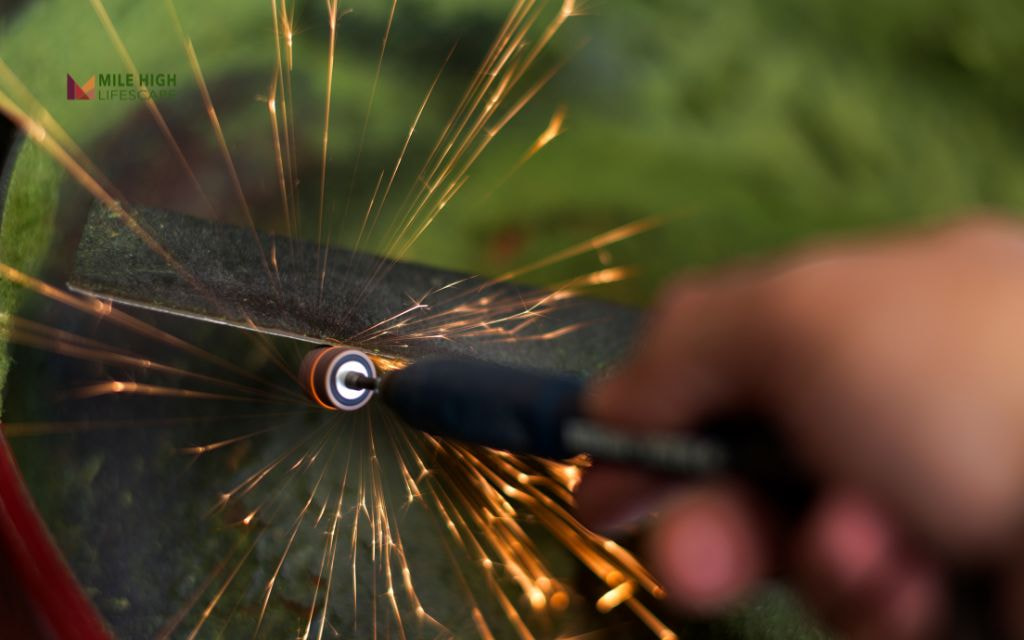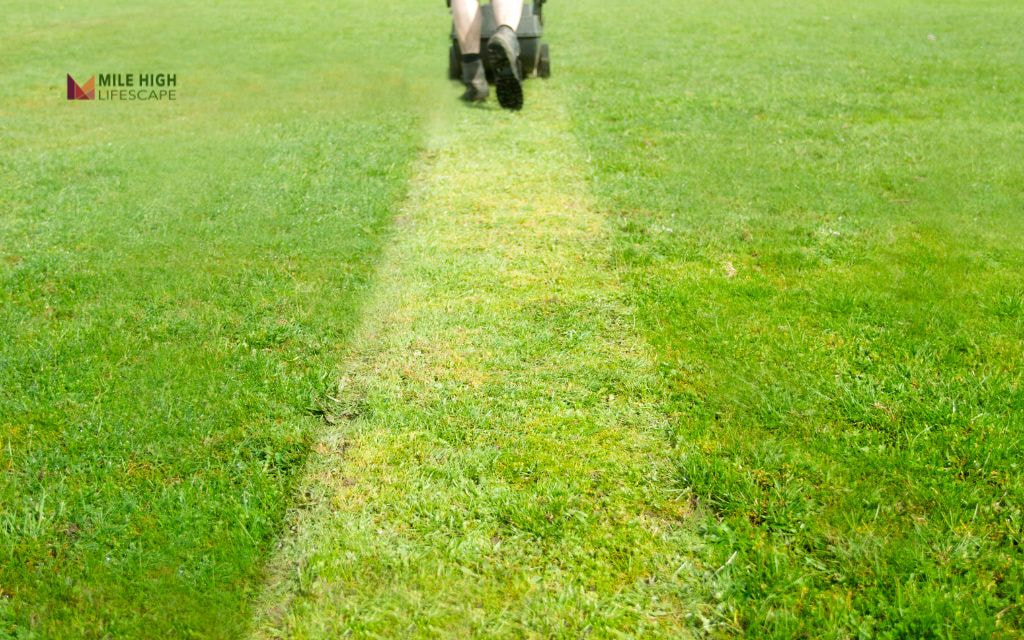Are your mowing habits secretly killing your lawn? After years of helping thousands of Denver homeowners, we have identified a critical truth: how you mow the lawn determines its health.
In this guide, we’ll reveal the professional secrets that keep our clients’ lawns vibrant year-round – simple adjustments to how you mow the lawn that deliver dramatic results. Keep reading to discover why your grass might be struggling and the straightforward solutions that will revolutionize your lawn care routine.
Grass Types and Ideal Mowing Heights
Mowing at the right height is a critical step in how to mow a lawn correctly, but this ideal height varies based on your specific grass type. Let’s break down what you need to know about grass varieties in Denver and their mowing requirements.
Colorado’s Common Grass Types
In the Denver Metro area, lawns typically feature either cool-season or warm-season grasses:
Cool-Season Grasses
Kentucky Bluegrass, Fescue, and Ryegrass thrive in Colorado’s climate with our cold winters and mild summers. These varieties grow most actively during spring and fall when temperatures range between 60-75°F, and they often go dormant during intense summer heat.
Warm-Season Grasses
Bermuda and Zoysia perform best during hot summer months when temperatures consistently exceed 80°F. These types go dormant and turn brown during Denver’s colder months but require less irrigation during summer.

Why Mowing Height Matters
The right cutting height creates a direct impact on your lawn’s:
- Root Development: Taller grass develops deeper root systems that access more soil moisture
- Drought Resistance: Proper height shades soil, reducing evaporation and water needs
- Weed Prevention: Taller grass blocks sunlight from reaching weed seeds
- Disease Resistance: Appropriate height reduces stress on grass plants
Optimal Cutting Heights by Grass Type
| Grass Type | Ideal Mowing Height | Special Considerations |
| Bermuda | 1-2 inches | Can be cut shorter on well-maintained lawns |
| Kentucky Bluegrass | 2.5-3.5 inches | Keep taller (3-3.5″) during summer heat |
| Fescue | 3-4 inches | Never cut below 3″ to maintain health |
| Zoysia | 1-2 inches | Tolerates lower cutting in well-established lawns |
| Ryegrass | 2.5-3 inches | Requires consistent height maintenance |
| Buffalo Grass | 2-3 inches | Native option requiring less frequent mowing |
Seasonal Adjustments to Height
During different seasons, adjust your mowing height to help your lawn thrive:
- Spring (April-May): Start at a slightly lower height (within your grass type’s range) to remove winter debris and stimulate new growth.
- Summer (June-August): Raise your cutting height to the upper end of the recommended range. This adjustment helps grass retain moisture and stay cooler during Denver’s hot, dry periods.
- Fall (September-October): Gradually lower the height back to mid-range to prevent snow mold and winter damage.
- Winter (November-March): For the final cut of the season, reduce height slightly to prevent matting under snow, but never cut below the minimum recommended height for your grass type.
The One-Third Rule
Professional landscapers follow the one-third rule: never remove more than one-third of the grass blade in a single mowing session.
This principle prevents stress on your lawn and helps maintain grass health. When you cut too much at once, the grass diverts energy from root development to blade regeneration.
This weakens the overall plant and creates opportunities for weeds to establish themselves. The one-third rule also prevents scalping, which exposes soil and leads to moisture loss.
For example, if your Kentucky Bluegrass stands at 4.5 inches tall and you want to maintain a 3-inch height, only cut 1.5 inches (one-third of 4.5) in your first mowing session. Wait a few days before cutting again to reach your desired 3-inch height.
Sharpen Lawn Mower Blades Regularly
When learning how to mow lawn properly, many homeowners overlook the critical role of blade maintenance. The condition of your mower blades directly determines your lawn’s health after every cut.
When you mow with sharp blades, they create clean, precise cuts across each grass blade – similar to scissors cutting paper. These clean cuts heal quickly, maintain moisture, and resist disease. Dull blades, however, tear and shred grass rather than cutting it.
Signs Your Blades Need Sharpening
Your lawn will tell you when your blades need attention. Look for these indicators:
- Uneven cutting across your lawn
- Grass tips turning brown within 1-2 days after mowing
- Ragged, torn appearance of individual grass blades
- Increased mowing time or the mower “pulling” to one side
- Need to make multiple passes over the same area
- Increased fuel consumption during mowing
When to Sharpen Your Blades
For most Denver homeowners, sharpen your mower blades:
- At the beginning of the growing season (early spring)
- Mid-season (typically early July)
- After hitting rocks, roots, or other hard objects
- When you notice signs of dull blades mentioned above
- After approximately 20-25 hours of mowing time
Professional landscapers often sharpen blades weekly, but this frequency isn’t necessary for most homeowners.

DIY Blade Sharpening Steps
Follow these steps to safely sharpen your mower blades:
- Safety First: Disconnect the spark plug wire and remove the key
- Access the Blade: Tilt the mower (follow manufacturer’s instructions) or use a mower lift
- Remove the Blade: Use the proper size wrench to loosen the center bolt (spray with penetrating oil if stuck)
- Clean the Blade: Remove built-up grass and debris with a wire brush
- Examine for Damage: Check for cracks or excessive wear that might require replacement
- Sharpen the Edge:
- Use a bench grinder, file, or sharpening kit
- Maintain the original angle (typically 30-45 degrees)
- Apply even pressure across the entire cutting edge
- Make several light passes rather than one aggressive one
- Balance the Blade: Use a blade balancer ($5-10 at hardware stores) to ensure even weight distribution
- Reinstall Properly: Tighten the center bolt to manufacturer specifications (typically 40-50 foot-pounds)
Mowing Frequency
Knowing when to mow the lawn is just as important as knowing how to mow it correctly. The right timing prevents stress on your grass while maintaining its appearance and health.
Understanding Growth Cycles
Grass doesn’t grow at a consistent rate throughout the year. In Denver’s climate, lawn growth follows predictable patterns:
- Spring Growth Surge: As temperatures warm in April and May, cool-season grasses experience rapid growth that may require more frequent mowing.
- Summer Growth Plateau: During hot periods, most grasses slow their growth to conserve resources.
- Fall Recovery Growth: A second, milder growth period occurs in September and October as temperatures moderate.
- Winter Dormancy: Most grass varieties essentially stop growing during cold months.
The Seasonal Mowing Calendar
For Denver Metro area lawns, follow this seasonal schedule as a starting point:
| Season | Mowing Frequency | Key Considerations |
| Spring (April-May) | Every 7-10 days | Increase frequency during peak growth periods |
| Summer (June-August) | Once per week | May need less during drought or extreme heat |
| Fall (September-October) | Every 10-14 days | Gradually reduce frequency as growth slows |
| Winter (November-March) | Rarely needed | Final cut before winter should be shorter |
The Growth-Based Approach
Rather than strictly following a calendar, many professionals recommend a growth-based approach:
- Determine your ideal grass height (see grass type chart in previous section)
- Mow when grass reaches one-third taller than your desired height
- Never remove more than one-third of the blade length in a single mowing
For example, if you maintain Kentucky Bluegrass at 3 inches, mow when it reaches 4 inches, removing just 1 inch of growth.

Adjusting for Weather Conditions
Local weather conditions require adjustments to your mowing schedule:
- During Drought: Reduce mowing frequency and raise cutting height
- After Heavy Rain: Wait until grass dries completely, even if it means delaying your regular schedule
- During Extreme Heat: Mow early morning or evening to reduce stress on grass
- During Rapid Growth Periods: You may need to mow every 5-6 days temporarily
Special Timing Considerations
Several factors might require you to adjust your standard mowing schedule:
- New Lawns: Newly seeded or sodded lawns require special care—wait until new grass reaches at least 3-3.5 inches before the first mow
- Shaded Areas: Grass in heavily shaded areas grows more slowly and requires less frequent mowing
- Fertilized Lawns: Expect increased growth for 2-3 weeks after fertilization
- Irrigated vs. Non-irrigated: Consistent watering promotes steady growth, while non-irrigated lawns may grow sporadically based on rainfall
Mowing In Different Patterns
Changing your mowing pattern with each cutting prevents soil compaction, reduces wheel ruts, and encourages upright growth. When you consistently mow in the same direction, grass begins to lean permanently in that direction.
Alternate between these patterns:
- North to south
- East to west
- Diagonal in one direction
- Diagonal in the opposite direction
This rotation helps grass grow straight and creates a more uniform appearance. For the distinctive striped look seen on golf courses and sports fields, consider a mower with a roller attachment that bends grass in alternating directions.
Mowing Conditions: When to Cut
Understanding how to mow a lawn properly requires more than just pushing a mower across your yard. Selecting the right conditions for mowing significantly impacts your lawn’s health and appearance.
The time of day you mow the lawn affects both your lawn’s health and your mowing experience:
Mid-Morning (9-11 AM)
Often ideal because:
- Morning dew has evaporated
- Temperatures remain moderate
- Grass has recovered from overnight moisture
- Allows cut grass time to heal before evening humidity
Late Afternoon (4-6 PM)
Another excellent option because:
- Heat stress is reduced
- Lawn has time to recover before nightfall
- Moisture levels are typically low
- Sun is less intense for the person mowing
Avoid Early Morning
Cutting wet, dew-covered grass leads to:
- Uneven cuts and clumping
- Potential spread of lawn disease
- Slipping hazards for the mower operator
- Greater strain on your mower engine
Avoid Midday
Mowing during peak heat (12-3 PM) causes:
- Additional stress on already heat-stressed grass
- Increased moisture loss from cut blades
- Uncomfortable conditions for the person mowing
- Greater risk of heat-related illness

Grass Clippings: Should Or Shouldn’t
Rather than collecting clippings, consider mulching them back into your lawn. Short clippings decompose quickly and return valuable nutrients to the soil – providing up to 25% of your lawn’s nitrogen needs when properly mulched.
However, bag your clippings when:
- Dealing with lawn disease
- Cutting extremely tall grass
- Managing weed-infested areas
If you choose to bag, consider composting your clippings rather than sending them to landfill. Mix grass clippings with brown materials like leaves or cardboard to create nutrient-rich compost for your garden.
Frequently Asked Questions (FAQs)
How often should I mow my lawn in Denver?
During peak growing season (late spring), mow once per week. Adjust based on growth rate – when grass is one-third taller than your desired height, it’s time to mow.
Should I mow before or after fertilizing?
Mow before fertilizing so nutrients can reach the soil properly without being removed with the clippings.
Can I mow in the morning?
Mid-morning is ideal after dew has evaporated but before afternoon heat. Avoid early mornings when grass remains wet.
What height should I set my mower for Kentucky Bluegrass?
Maintain Kentucky Bluegrass between 2.5-3.5 inches tall. During summer heat, keep it at the higher end of this range.
How long should I wait before mowing newly seeded grass?
Wait until new grass reaches at least 3-3.5 inches tall before the first mow. Use sharp blades and avoid turning sharply on the new turf.
Conclusion
Implementing these mowing techniques transforms your lawn care routine from potentially harmful to actively beneficial. Remember these key practices to mow the lawn properly:
- Cut at the proper height for your specific grass type
- Follow the one-third rule
- Maintain sharp blades
- Vary your mowing pattern
- Choose appropriate timing and conditions
- Utilize clippings as a resource
For those seeking professional-level results without the time investment, Mile High Lifescape offers comprehensive lawn mowing services throughout the Denver Metro area.
Our experienced team delivers precise cuts that promote lawn health while saving you time and effort. Contact us at (303) 877-9091 for a free quote.
